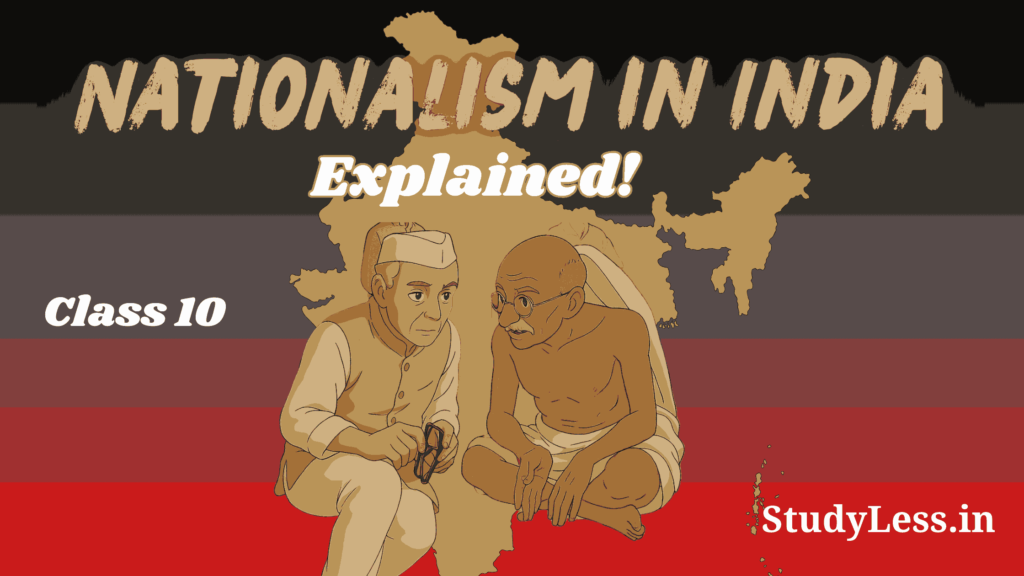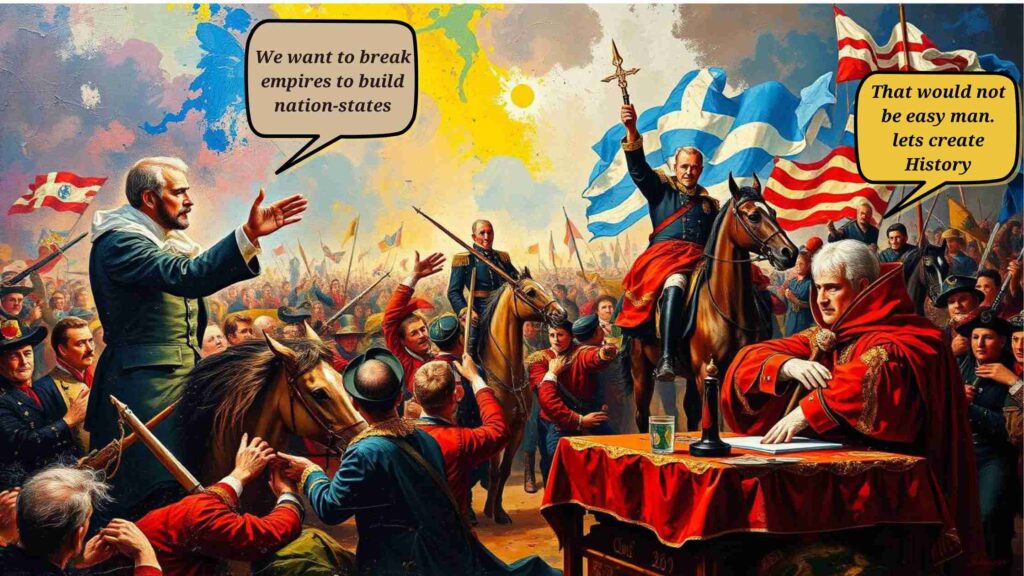
Unlocking “The Rise of Nationalism in Europe” – Your Ultimate Guide to Conquering Class 10 CBSE History! 🌟
Confused about dates, treaties, and endless revolutions? Struggling to connect the dots between the French Revolution and World War I? You’re not alone! Class 10 CBSE students often find “The Rise of Nationalism in Europe” overwhelming – a maze of fragmented kingdoms, complex ideologies, and battles that shaped modern nations. But what if I told you this chapter is not about memorizing, but understanding a thrilling story of dreams, drama, and defiance?
This guide is crafted just for you – the student battling dry textbooks, confusing timelines, or exam stress. Here’s how we fix your pain points:
✅ No more confusion: Broken into bite-sized topics with simple headings and real-life analogies (think WhatsApp groups merging into nations!).
✅ No more forgetting: Engaging stories and quizzes to make Mazzini, Bismarck, and Garibaldi feel like characters from your favorite show.
✅ No more exam fear: Clear tables, maps, and MCQs designed to mirror CBSE patterns.
Why “The Rise of Nationalism in Europe” Matters?
From the French Revolution’s cry for liberty to the Balkan powder keg that ignited WWI, nationalism wasn’t just a chapter – it was a rollercoaster of hope, betrayal, and transformation. Discover how:
- Artists turned nations into heroic symbols like Marianne and Germania.
- Liberals clashed with conservatives, and peasants fought for bread and freedom.
- Nationalism’s dark side led to imperialism, wars, and lessons that still shape our world today.
Ready to ace your boards and actually enjoy the ride? Let’s dive in! 🚀
Table of Contents
🌍 Frédéric Sorrieu’s Dream: A World of United Nations!
Let me tell you a story about a French artist named Frédéric Sorrieu. In 1848, he painted a series of four prints showing his dream world. Imagine a giant parade where people from Europe and America—men, women, kids, rich, poor—walk together, waving flags and cheering for freedom. At the front stands the Statue of Liberty, holding a torch (for knowledge) and a Charter of Rights. Below her lie broken chains and crowns—symbols of kings and empires that once ruled.
Why is this important?
Sorrieu’s vision shows how people wanted to replace old empires with nation-states—countries where citizens share a common identity, not just a king. Think of it like your school: students from different backgrounds unite under one flag during Sports Day!
Fun Fact:
Did you know Germany didn’t exist as a country in 1848? Sorrieu painted Germans united under a black-red-gold flag, hoping they’d become one nation. It finally happened in 1871!
🏰 What’s a Nation-State? Let’s Break It Down!
Before the 1800s, Europe was like a puzzle with mismatched pieces. Rulers (like kings and queens) controlled empires where people spoke different languages and followed different cultures. Nationalism changed everything!
| Old Europe (Empires) | New Europe (Nation-States) |
|---|---|
| Ruled by kings 👑 | Ruled by citizens 🗳️ |
| Example: Austrian Empire | Example: Germany (1871) |
| Mixed languages & cultures 🌍 | One main language/culture 🏴 |
Real-Life Connection:
Imagine your school merging with 10 others. At first, chaos! But slowly, you create a new identity. That’s how Germany unified 39 states into one nation!
✨ How Did Nationalism Change Europe?
- People Power: Kings lost control. Citizens demanded rights, like after India’s independence!
- Shared Identity: People thought, “We speak the same language—let’s form a country!”
- Revolutions: Just like Bhagat Singh or Rani Lakshmibai, Europeans fought for freedom.
Story Time:
In 1848, revolutions exploded across Europe. Workers, students, and farmers shouted, “We want democracy!” It was like India’s 1857 revolt but on a continental scale!
Quote to Think About:
“A nation is made by the people, not by kings.” — Giuseppe Mazzini, Italian revolutionary.
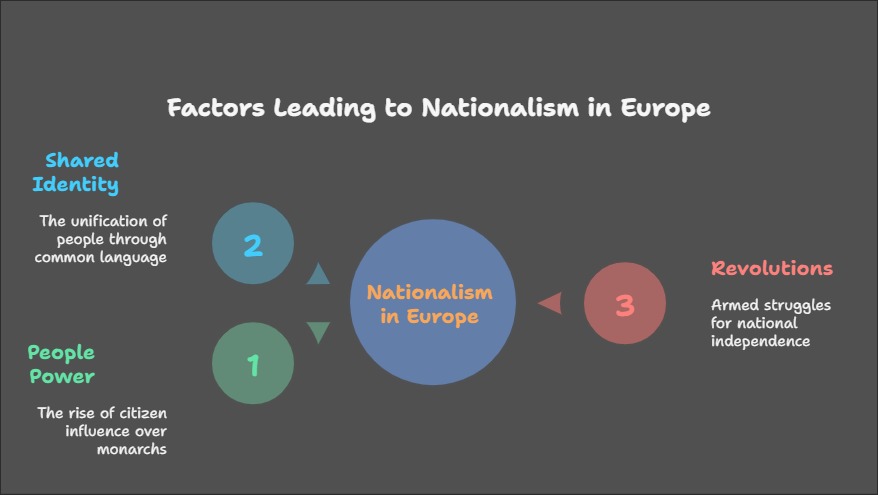
📚 Let’s Test Your Understanding!
Multiple Choice Questions (MCQs): The Rise of Nationalism in Europe
- What did Sorrieu’s painting symbolize?
a) A royal wedding
b) A world of democratic nations
c) A cricket match
Answer: b) A world of democratic nations. - Why did Sorrieu show a German flag in 1848?
a) Germany already existed
b) To show hope for unity
c) He liked the colors
Answer: b) To show hope for unity.
Assertion & Reason:
- Assertion: The broken crowns in Sorrieu’s painting represent fallen empires.
Reason: He wanted to show the rise of democracy.
a) Both are true.
b) Both are false.
Answer: a) Both are true.
Short Questions:
- Name two symbols held by the Statue of Liberty.
Answer: Torch (Enlightenment) and Charter of Rights. - What did the German flag in Sorrieu’s painting represent?
Answer: Hope for unifying German-speaking states.
🌟 Fun Corner: Nationalism Today!
- Then: Europeans fought to unite their people.
- Now: India’s states celebrate Onam, Baisakhi, and Durga Puja but stand united as ONE nation.
Food for Thought:
If your school had to design a flag representing all students, what symbols would you include?
🔥 What’s Coming Up? A Revolution That Changed the World!
Imagine students in your school overthrowing the principal to demand better rules. The French Revolution (1789) was like that—but with guillotines and a fight for “Liberty, Equality, Fraternity”. Next, we’ll see how this revolution became the spark for nationalism across Europe.
Teaser Question:
What if Sorrieu painted India’s freedom struggle? Who would lead the parade—Gandhi with a charkha or Netaji with the Azad Hind Fauj?
🧩 Why Should You Care?
When you argue with friends over Hindi vs. Tamil but still feel Indian, that’s nationalism! Europe’s story teaches us that unity is built through struggles, just like our freedom fighters showed.
Next Up: The French Revolution and the Idea of the Nation—where angry Parisians shouted, “Enough is enough!” and changed history forever. Stay tuned! 🗡️🇫🇷
🌍 Quick Recap: The Rise of Nationalism in Europe
- Sorrieu’s 1848 vision → Dream of democratic nations.
- Nation-states replaced empires → People over kings!
- Nationalism = Shared identity + Struggles.
Fact to Remember:
The word “nationalism” comes from the Latin “natio”, meaning “birth” or “tribe”. It’s about being born into a community with shared values!
🌟 The French Revolution: Birth of the Nation!
Hey there! Let’s dive into how the French Revolution (1789) became the big bang of nationalism in Europe. Imagine your school suddenly replacing the principal with a student council – that’s how France shifted power from kings to citizens!
Key Idea:
The Revolution declared, “People are the nation!” Sovereignty (power) moved from the king to ordinary French citizens.
🗝️ How Did the French Revolution Create a National Identity?
The revolutionaries wanted everyone to feel French first. Here’s how they did it:
- Symbols of Unity:
- A new flag (tricolour) replaced the royal flag.
- Oaths, hymns, and festivals celebrated the nation.
- Martyrs (heroes who died for freedom) were honored.
- Equal Rights:
- Uniform laws for all citizens.
- Abolished internal taxes and introduced standard weights/measures.
- One Language:
- Regional dialects were discouraged. French (as spoken in Paris) became the national language.
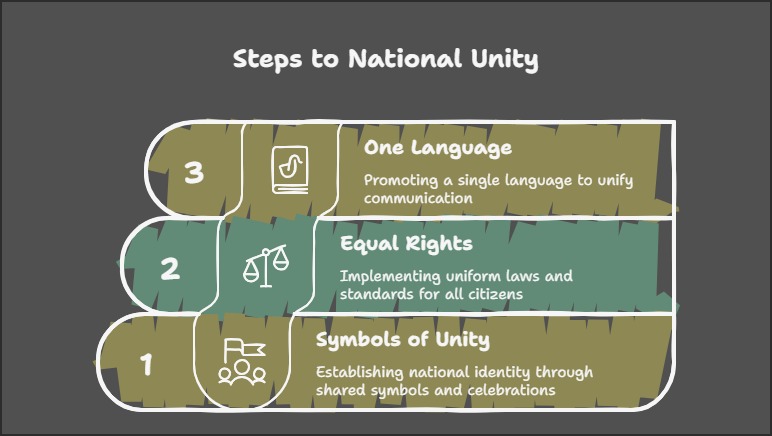
Fun Fact:
The French motto “Liberty, Equality, Fraternity” became the blueprint for democracies worldwide!
⚔️ Napoleon: The Mixed Legacy
Napoleon Bonaparte, a French leader, spread revolutionary ideas across Europe through wars. Let’s weigh his impact:
| Positive Reforms 🌟 | Negative Reactions 💔 |
|---|---|
| Introduced Napoleonic Code (equality before law, no birth privileges). | Forced conscription (drafting soldiers). |
| Abolished feudalism, freed peasants. | Increased taxes and censorship. |
| Improved transport and trade. | Conquered nations felt controlled, not liberated. |
Real-Life Example:
Imagine your principal enforces strict new rules but also starts a cafeteria upgrade. Some students cheer; others protest!
Quote to Remember:
“A throne is just a bench covered in velvet.” – Napoleon Bonaparte
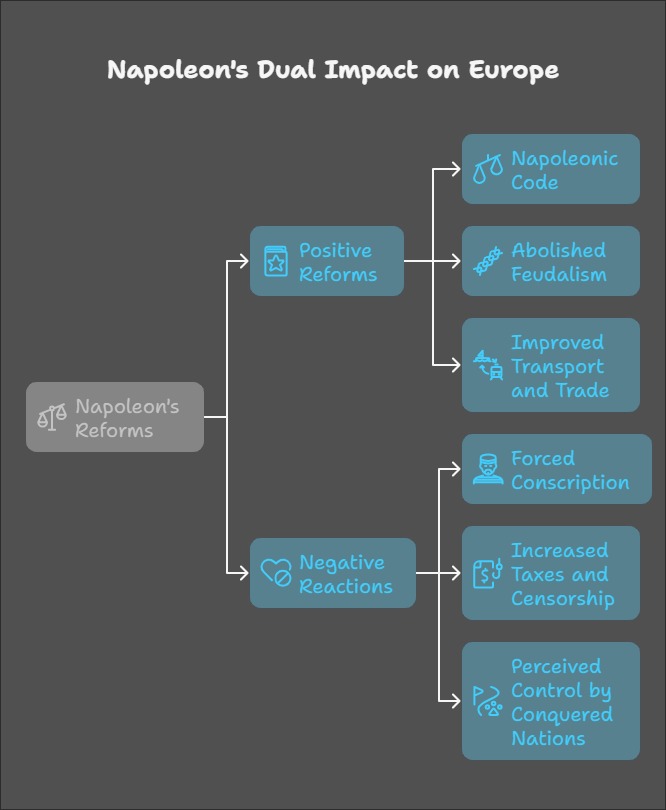
🌍 Europe’s Reaction: From Cheers to Tears
At first, countries like Switzerland and Italy welcomed French armies as liberators. But soon, people realized:
- Freedom ≠ French Control: Taxes and censorship outweighed reforms.
- Mixed Feelings: Peasants loved land reforms; businessmen hated trade restrictions.
Story Time:
In Holland, locals initially celebrated the end of feudalism. But when Napoleon forced Dutch youth into his army, they rebelled – like your sibling borrowing your phone and never returning it!
📚 Let’s Test Your Knowledge!
MCQs (Choose the Correct Answer): The Rise of Nationalism in Europe
- What did the French Revolution transfer from the king to citizens?
a) Gold reserves
b) Sovereignty (power)
c) Palace ownership
Answer: b) Sovereignty. - What was the Napoleonic Code?
a) A secret spy language
b) A law ensuring equality
c) A type of French bread 🥖
Answer: b) A law ensuring equality.
Assertion & Reason:
- Assertion: Napoleon simplified trade in Europe.
Reason: He introduced uniform weights and measures.
a) Both are true, and the reason explains the assertion.
b) Both are false.
Answer: a) Both are true.
Short Questions:
- Name two symbols introduced by French revolutionaries.
Answer: Tricolour flag, national hymns. - Why did conquered nations turn against Napoleon?
Answer: Forced conscription, taxes, and lack of political freedom.
🌟 Food for Thought!
If you had to design a national festival for your school, what traditions would you include to unite everyone?
🔥 What’s Next? The Making of Nationalism in Europe!
Think of nationalism as a puzzle. The French Revolution gave Europe a few pieces, but how did the rest fit together? Next, we’ll meet thinkers, artists, and rebels who turned “us vs. them” into “we the people”!
Teaser Question:
Can you guess which country used folk songs and fairy tales to build national pride? (Hint: Think castles and philosophers!)
🧩 Why Does This Matter to YOU?
When your class votes for a new monitor, you’re using the same idea the French fought for: power to the people! Europe’s journey from kingdoms to nations shows how ordinary folks can reshape history.
Next Up: The Making of Nationalism in Europe – where poets, painters, and protests turned fragmented lands into proud nations! 🖌️🗺️
The Making of Nationalism in Europe
🌟 Europe in the 1700s: A Patchwork of Kingdoms!
Imagine your school’s annual day event where every class performs separately, speaks different languages, and follows different rules. That’s how Europe looked in the mid-1700s! Countries like Germany, Italy, or Switzerland didn’t exist yet. Instead, there were tiny kingdoms, duchies, and city-states ruled by princes and aristocrats.
Key Idea:
People in these regions didn’t feel united. They spoke different languages, followed different cultures, and had no common identity.
🗺️ The Habsburg Empire: A Mix of Cultures!
Let’s zoom into the Habsburg Empire (ruling Austria-Hungary). It was like a giant thali with diverse dishes:
- Alpine regions (Tyrol, Austria) – German-speaking aristocrats.
- Bohemia – Czech-speaking peasants.
- Hungary – Half spoke Magyar, half other dialects.
- Lombardy & Venetia – Italian-speaking provinces.
| Region | Language/Culture |
|---|---|
| Bohemia | Czech peasants, German nobles |
| Hungary | Magyar + local dialects |
| Transylvania | Romanian-speaking people |
Fun Fact:
The Habsburg Empire was like a mismatched puzzle – the only “glue” holding it together was loyalty to the emperor!
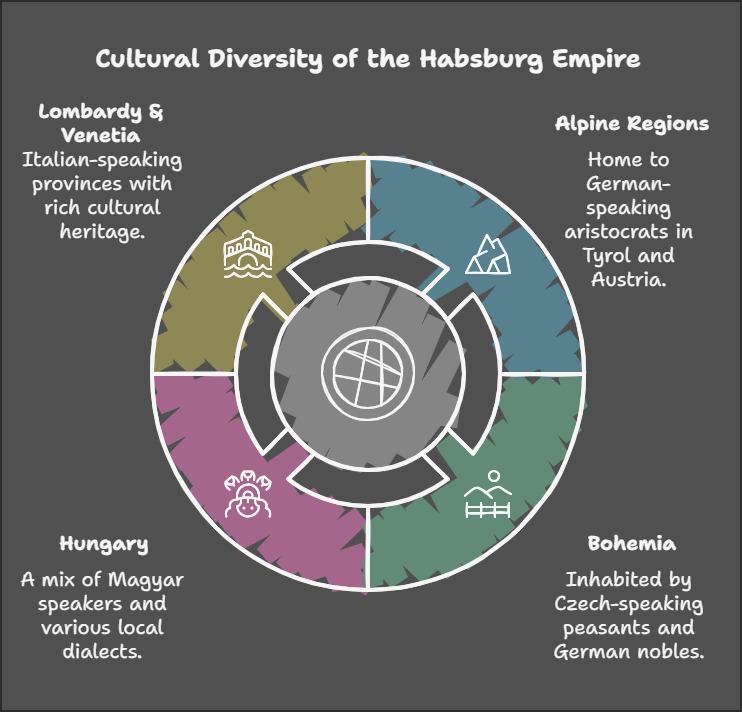
❓ Why Was Unity So Hard?
- No Common Identity: A farmer in Bohemia had nothing in common with a noble in Hungary.
- Language Barriers: Imagine trying to work on a group project where everyone speaks different languages!
- Autocratic Rule: Kings and aristocrats cared more about power than uniting people.
Real-Life Connection:
Think of your apartment complex – if every floor had its own rules and language, chaos would follow! That’s pre-nationalism Europe.
🌱 Seeds of Nationalism: How Did It Begin?
So, how did people start feeling “we are one nation”?
- Shared Struggles: Peasants and workers began resisting unfair taxes and feudal dues.
- Cultural Pride: Folktales, dances, and local languages became tools to celebrate uniqueness.
- New Ideas: Thinkers and writers asked: “Why should we obey distant rulers who don’t understand us?”
Quote to Ponder:
“A nation is a soul, a spiritual principle.” – Ernest Renan, French thinker.
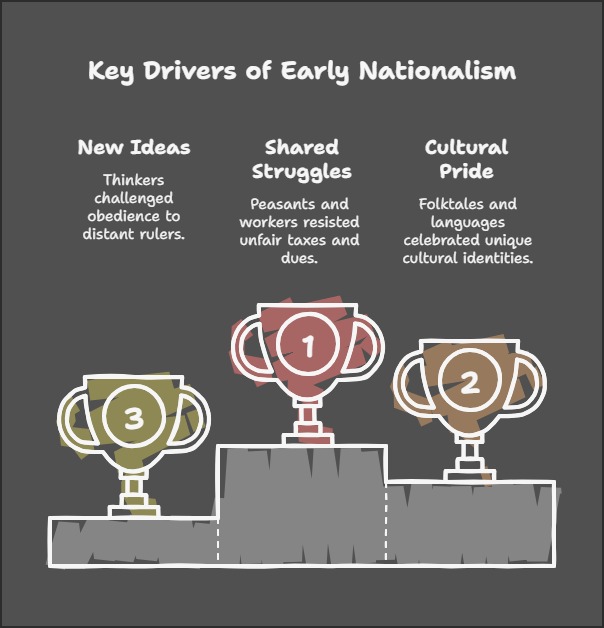
📚 Let’s Test Your Knowledge!
MCQs (Choose the Correct Answer): The Rise of Nationalism in Europe
- What best describes 18th-century Europe?
a) United nation-states
b) A mix of small kingdoms
c) A single empire
Answer: b) A mix of small kingdoms. - What held the Habsburg Empire together?
a) Shared language
b) Loyalty to the emperor
c) Common festivals
Answer: b) Loyalty to the emperor.
Assertion & Reason:
- Assertion: The Habsburg Empire faced challenges in uniting people.
Reason: Its regions had diverse languages and cultures.
a) Both are true, and the reason explains the assertion.
b) Both are false.
Answer: a) Both are true.
Short Questions:
- Name two regions in the Habsburg Empire and their languages.
Answer: Bohemia (Czech), Lombardy (Italian). - Why did people in Europe lack a common identity in the 1700s?
Answer: Different languages, cultures, and rulers.
🌟 Food for Thought!
If your state had to design a flag representing only its culture, what symbols would you choose? How would it differ from the national flag?
👑 Coming Up: The Aristocracy vs. the New Middle Class!
Imagine a tug-of-war between old-money families and ambitious newcomers. Next, we’ll see how the aristocracy (land-owning nobles) clashed with the middle class (teachers, lawyers, businessmen) over power and ideas. Who do you think won?
Teaser Question:
Can a lawyer wearing a suit defeat a prince riding a horse? Let’s find out! 🐎⚖️
🧩 Why Does This Matter?
When you cheer for your state’s cricket team but also for Team India, you’re balancing regional and national pride – just like Europe’s journey from fragments to nations!
Next Up: The Aristocracy and the New Middle Class – where old meets new in a battle for Europe’s future! ⚔️💼
The Aristocracy and the New Middle Class
🏰 The Aristocracy: Europe’s “Old Money” Elite
Picture your school’s strict prefects who get special privileges. That’s how Europe’s landed aristocracy worked in the 1800s! They were a small but super-powerful group:
- Owned huge estates in villages and fancy city homes.
- Spoke French (the “cool” language of diplomacy and high society).
- Married within their circle to keep power and wealth.
Fun Fact:
French was like today’s English – the global language of elites. Even German or Italian nobles used French to sound posh! 🥖
But here’s the twist:
While aristocrats partied in palaces, most Europeans were peasants. In Western Europe, they farmed small lands. In Eastern Europe, they toiled as serfs (like permanent workers) on giant estates owned by nobles.
🏙️ The New Middle Class: Fresh Faces with New Ideas
Now, imagine a group of students starting a tech club to challenge the prefects. That’s the new middle class! They emerged because of:
- Industrial Revolution: Factories and trade grew in England, France, and parts of Germany.
- New Jobs: Industrialists, lawyers, doctors, and businessmen became the “middle” layer between rich nobles and poor workers.
| Aristocrats 👑 | Middle Class 💼 |
|---|---|
| Owned land | Ran factories/businesses |
| Spoke French | Used local languages |
| Hated change | Wanted democracy and equality |
Real-Life Connection:
Think of old family businesses vs. startups like Zomato or Ola! The middle class were the “startups” of 19th-century Europe.
💥 Clash of Classes: Why It Matters for Nationalism
The middle class hated aristocratic privileges (like tax exemptions). They demanded:
- End of birth-based rights: “Why should nobles get special treatment?”
- National Unity: “If we’re all equal, let’s unite under one flag!”
Quote to Ponder:
“The old world is dying, and the new world struggles to be born.” – Antonio Gramsci, thinker.
Story Time:
In Germany, middle-class teachers and lawyers secretly met in cafes to discuss national unity. It was like planning a surprise party… but for revolution! ☕🗣️
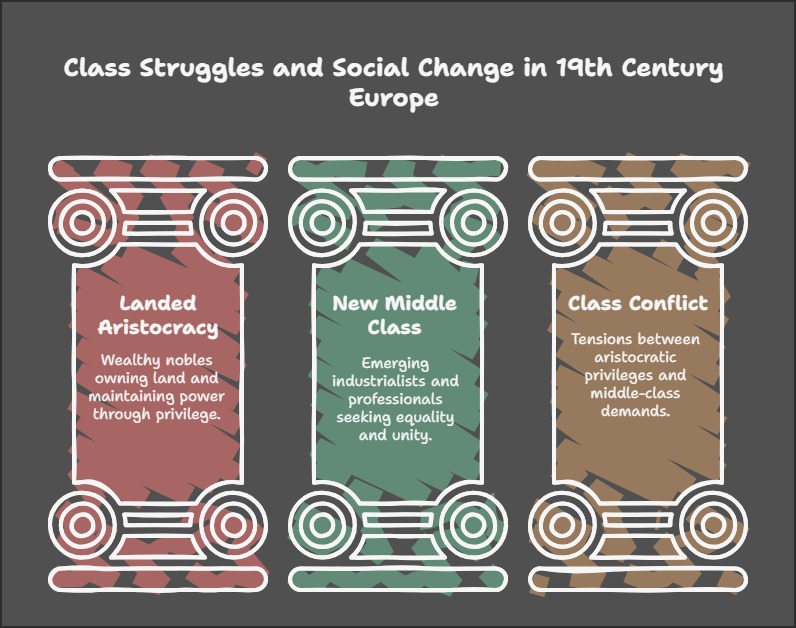
📚 Let’s Test Your Knowledge!
MCQs (Choose the Correct Answer): The Rise of Nationalism in Europe
- What language did European aristocrats use for diplomacy?
a) German
b) French
c) English
Answer: b) French. - Who formed the new middle class?
a) Serfs
b) Industrialists and lawyers
c) Kings
Answer: b) Industrialists and lawyers.
Assertion & Reason:
- Assertion: The middle class supported national unity.
Reason: They wanted to abolish aristocratic privileges.
a) Both are true, and the reason explains the assertion.
b) Both are false.
Answer: a) Both are true.
Short Questions:
- Name one difference between aristocrats and the middle class.
Answer: Aristocrats owned land; the middle class ran businesses. - Why did the middle class oppose aristocrats?
Answer: They disliked birth-based privileges and wanted equality.
🌟 Food for Thought!
If your school replaced “prefects” with a student council elected by all, how would it change power dynamics? That’s what the middle class wanted!
🌍 What’s Next? Liberal Nationalism – Freedom vs. Control!
Imagine your principal says, “No more uniforms! But you must attend coding classes.” Would you cheer or protest? Liberal Nationalism was all about balancing freedom and rules. Next, we’ll explore how this idea shaped Europe’s nation-states.
Teaser Question:
Can you have too much freedom? Liberals said “No!” – but how did they convince kings to listen?
🧩 Why Does This Matter to YOU?
When you debate school rules or equal opportunities, you’re channeling the same spirit as Europe’s middle class! The Rise of Nationalism in Europe shows how ordinary people can redefine power.
Next Up: What Did Liberal Nationalism Stand For? – where thinkers, protests, and pamphlets turned “freedom” into a revolution! 📜✊
What did Liberal Nationalism Stand for?
🌟 Liberal Nationalism: Freedom, But Not for All?
Let’s break down this big word: liberalism comes from liber (Latin for “free”). For 19th-century Europeans, it meant fighting for individual rights and equality before the law. Imagine your school replacing strict teachers with a student council – that’s liberalism!
🗳️ Political Liberalism: Power to the People (Well, Some People)
Liberals wanted:
- Government by Consent: Leaders chosen by citizens, not born into royalty.
- Constitutions: Rulebooks for fair governance (like your school’s code of conduct!).
- End of Privileges: No special rights for nobles or clergy.
But Wait!
- Voting Rights? Only for men who owned property. Women and poor men? Excluded!
- Napoleon’s Hypocrisy: His Napoleonic Code gave equality but treated women as minors (they needed male approval for everything!).
Fun Fact:
In 1793, the Jacobins (radical French revolutionaries) let all adult men vote – even without property! But this lasted only a year.
💰 Economic Liberalism: Let’s Trade Freely!
Middle-class liberals hated trade barriers. Imagine you’re selling samosas:
- Problem: Each state in Germany had its own currency, taxes, and weight units (like elle for cloth, varying by city!).
- Solution: Zollverein (1834) – a German “customs union” that removed taxes between states and standardized weights.
| Before Zollverein 🛑 | After Zollverein 🚀 |
|---|---|
| 11 customs checks between Hamburg-Nuremberg | 0 checks! |
| 30+ currencies | Just 2 currencies |
| Chaotic weights (e.g., elle = 53-65 cm) | Standard measures |
Story Time:
A German merchant in 1833 paid 5% tax at each of 11 checkpoints. After Zollverein, he saved time and money – boosting trade and nationalism!
🚫 The Limits of Liberal Nationalism
- Excluded Voices: Women like Louise Otto (German feminist) protested: “Women’s work for the nation is unpaid and unrecognized!”
- Class Bias: Poor men couldn’t vote. Liberals cared more about property rights than universal equality.
Quote to Ponder:
“Liberty for the wolves is death for the lambs.” – Philosopher Isaiah Berlin.
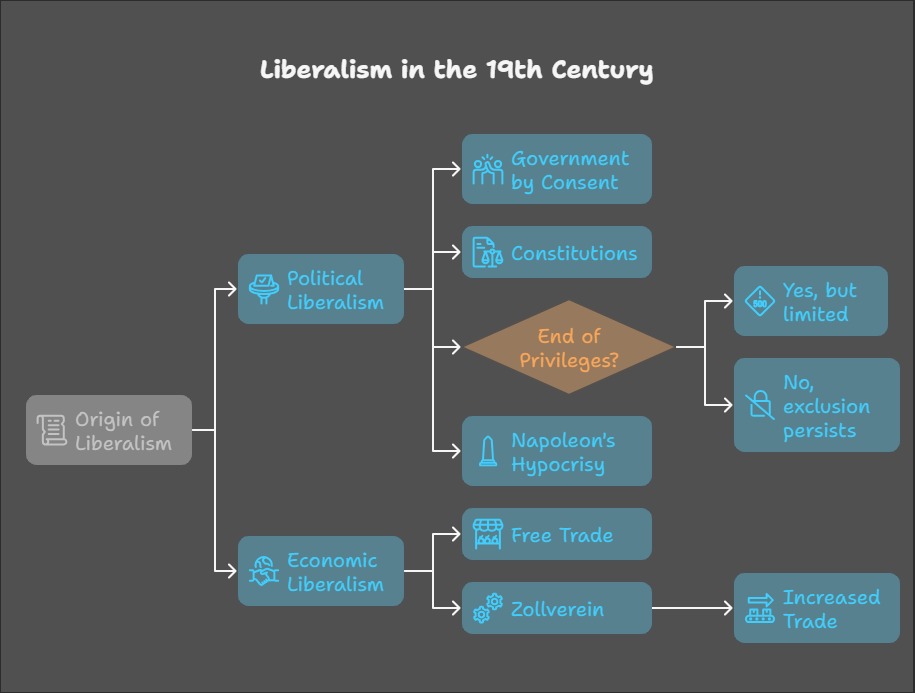
📚 Let’s Test Your Knowledge!
MCQs (Choose Wisely!): The Rise of Nationalism in Europe
- What did ‘liberalism’ mean in 19th-century Europe?
a) Free snacks for all
b) Freedom and equality before law
c) Absolute monarchy
Answer: b) Freedom and equality before law. - Who could vote under liberal regimes?
a) All adults
b) Property-owning men
c) Only kings
Answer: b) Property-owning men.
Assertion & Reason:
- Assertion: Zollverein boosted German nationalism.
Reason: It unified trade and reduced economic barriers.
a) Both are true, and the reason explains the assertion.
b) Both are false.
Answer: a) Both are true.
Short Questions:
- Name one economic reform liberals demanded.
Answer: Abolition of internal customs duties. - Why were women excluded from voting?
Answer: Laws treated them as dependents of fathers/husbands.
🌟 Food for Thought!
If your class council allowed only A+ students to vote, would it be fair? Liberals faced similar criticism for excluding the poor!
⚖️ What’s Next? A New Conservatism After 1815!
Imagine your school’s strict principal returning after a student council trial, saying, “Back to old rules!” That’s what happened in Europe post-1815. Conservatives (kings, nobles, clergy) pushed back against liberalism.
Teaser Question:
Can you balance tradition and change? Conservatives said “Yes!” – but how?
🧩 Why Does This Matter?
The Rise of Nationalism in Europe shows how ideas like liberty and equality faced hurdles – just like debates today on who gets rights. When you argue for fairer school rules, you’re a mini-liberal!
Next Up: A New Conservatism after 1815 – where kings, spies, and secret meetings tried to “undo” revolutions! 🤫👑
🌟 A New Conservatism after 1815: Kings Fight Back!
After Napoleon’s defeat in 1815, Europe’s kings and nobles panicked. They thought, “We can’t let another revolution happen!” So, they created conservatism – a policy to preserve monarchy, religion, and old social hierarchies. But wait, they weren’t totally against change!
Key Idea:
Conservatives wanted to modernize traditions. For example:
- Keep kings but build stronger armies and bureaucracies.
- End feudalism (serfdom) to make economies more efficient.
Fun Fact:
The Congress of Vienna (1815) was like a royal reunion party where kings redrew Europe’s map to erase Napoleon’s changes.
🗺️ The Congress of Vienna: Europe’s Map Gets a Makeover!
Hosted by Austria’s Chancellor Duke Metternich, the Congress aimed to:
- Restore Old Dynasties: The Bourbon family returned to rule France.
- Contain France: Neighboring states like the Netherlands and Prussia got extra land to block French expansion.
- Balance Power: Russia got Poland, Prussia got Saxony – everyone got a slice!
| Napoleon’s Changes 🗡️ | Congress of Vienna’s Fix 👑 |
|---|---|
| Unified German states (39) | Kept them divided to weaken nationalism |
| Spread revolutionary ideas | Censored books, newspapers, and songs |
Real-Life Connection:
Imagine your school principal cancels all student councils and brings back strict prefects. That’s what conservatives did in Europe!

🔒 Autocratic Regimes: No Freedom of Speech!
Post-1815, conservative governments:
- Banned Criticism: Jail for anyone questioning kings!
- Censored Media: Newspapers couldn’t mention “liberty” or “equality”.
- Spied on People: Secret police monitored cafes and clubs.
Story Time:
In Prussia, students singing revolutionary songs were arrested. It’s like getting detention for humming “We Shall Overcome”!
Quote to Remember:
“When France sneezes, Europe catches a cold.” – Duke Metternich (on revolutions spreading).
📚 Test Your Knowledge!
MCQs (Pick the Best Answer): The Rise of Nationalism in Europe
- What was the main goal of the Congress of Vienna?
a) Promote democracy
b) Restore old monarchies
c) Unite Germany
Answer: b) Restore old monarchies. - Who hosted the Congress of Vienna?
a) Napoleon
b) Duke Metternich
c) Louis XVI
Answer: b) Duke Metternich.
Assertion & Reason:
- Assertion: Conservatives supported modern armies.
Reason: They wanted to strengthen monarchies.
a) Both are true, and the reason is correct.
b) Both are false.
Answer: a) Both are true.
Short Questions:
- Name one way conservatives tried to control ideas.
Answer: Censorship of newspapers/books. - Why did the Congress of Vienna give Prussia new territories?
Answer: To block French expansion.
🌟 Food for Thought!
If your school banned all social media to “protect traditions”, would you support it? Conservatives faced similar debates!
🔥 What’s Next? The Revolutionaries: Secret Heroes!
Imagine students forming underground clubs to fight strict rules. That’s exactly what revolutionaries did! Next, meet the rebels, spies, and dreamers who kept the flame of liberty alive.
Teaser Question:
Can you guess which Italian revolutionary said “Ideas sleep in the people’s hearts but never die”? 🤫🗡️
🧩 Why Does This Matter?
The Rise of Nationalism in Europe shows how power struggles shape history. When you debate school rules, you’re part of this age-old clash between control and freedom!
Next Up: The Revolutionaries – where secret societies, daring escapes, and radical pamphlets kept hope alive in a conservative world! 🌍✊
The Revolutionaries: Europe’s Secret Freedom Fighters
After 1815, Europe’s kings cracked down on anyone demanding liberty. Imagine your school banning all clubs – so students start secret study groups to fight unfair rules. That’s what liberals did! They formed underground societies to train revolutionaries and spread ideas of freedom and nation-states.
Giuseppe Mazzini: The “Superstar” Revolutionary
Meet Giuseppe Mazzini, an Italian hero who hated kings. At 24, he was exiled for plotting a revolt. But he didn’t give up! He founded:
- Young Italy: A secret society to unite Italy into one democratic republic.
- Young Europe: A bigger group with members from Poland, France, and Germany.
Mazzini’s Big Idea:
He believed nations were “natural units” created by God. Italy, split into tiny states, needed unification to be free. His passion scared conservatives – Austria’s Chancellor Metternich called him “the most dangerous enemy”!
Why Were Secret Societies Important?
- Training Grounds: They taught members guerrilla tactics and propaganda.
- Global Network: Mazzini inspired similar groups in Germany, Poland, and France.
- Symbol of Hope: Like Bhagat Singh in India, Mazzini became a legend for resisting oppression.
Fun Fact:
Mazzini’s letters were written in invisible ink to avoid detection!
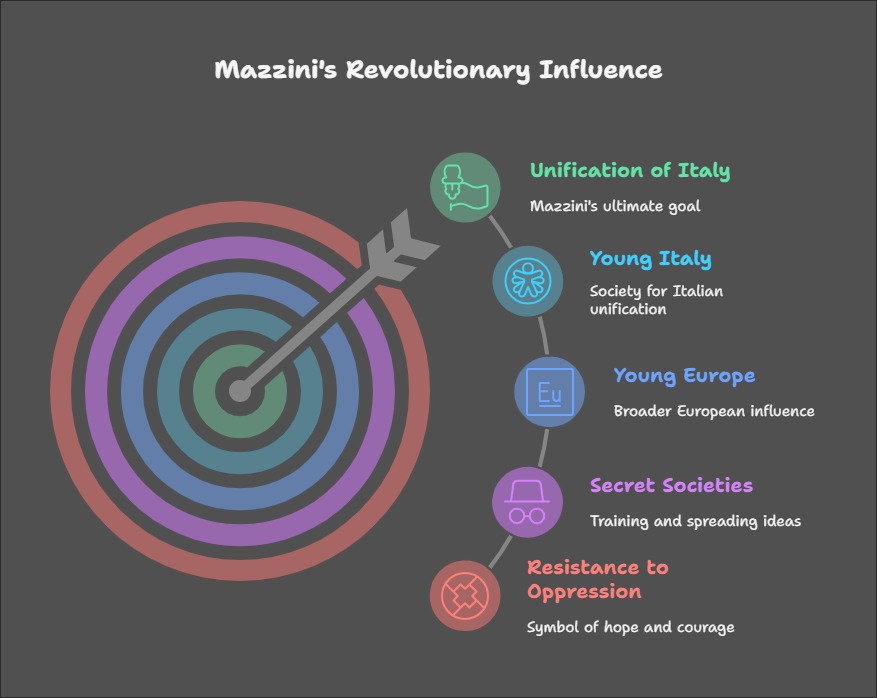
Quick Comparison: Mazzini’s Societies
| Society | Goal | Members |
|---|---|---|
| Young Italy | Unite Italy into a republic | Italian youth |
| Young Europe | Spread democracy across Europe | Poles, French, Germans, Italians |
Test Your Knowledge!
MCQs: Th The Rise of Nationalism in Europee Rise of Nationalism in Europe
- Why did revolutionaries form secret societies after 1815?
a) To organize picnics
b) To oppose monarchies and fight for liberty
c) To learn baking
Answer: b) To oppose monarchies and fight for liberty. - What did Mazzini believe about nations?
a) They should be ruled by kings
b) They were God’s natural units for mankind
c) They were unimportant
Answer: b) They were God’s natural units.
Assertion & Reason:
- Assertion: Metternich feared Mazzini.
- Reason: Mazzini’s ideas threatened conservative rule.
a) Both true, and the reason is correct.
b) Both false.
Answer: a)
Short Questions:
- Name one secret society founded by Mazzini.
Answer: Young Italy or Young Europe. - Why was Mazzini exiled?
Answer: For attempting a revolution in Liguria.
Food for Thought:
If you started a secret club to change school rules, what would your first mission be?
Coming Up: The Age of Revolutions (1830-1848)
Mazzini lit a spark, but soon Europe would explode into full-blown revolutions. Next, we’ll see how students, workers, and poets turned protests into new nations – and why 1848 is called the “Year of Revolutions”!
Teaser:
Can you guess which European capital saw rebels fighting on barricades made of furniture? Hint: It’s known for croissants and art!
Why This Matters Today:
Just like social media helps activists today, secret pamphlets and symbols kept hope alive in 19th-century Europe. The fight for rights is never easy – but every revolution starts with a small group of brave hearts!
🌟 The Age of Revolutions: 1830-1848 – Europe’s Rollercoaster Ride!
Imagine your school suddenly replacing a strict principal with a student-friendly one… only to see protests erupt in other schools too! That’s what happened in Europe between 1830-1848. Let’s break it down:
🗝️ France Sneezes, Europe Catches a Cold!
In 1830, France kicked off the revolution party:
- What Happened? The Bourbon kings (old rulers) were overthrown. Louis Philippe, a “citizen king,” took power as a constitutional monarch.
- Ripple Effect: Belgium broke free from Dutch control, inspired by France!
Fun Fact:
Metternich, Austria’s conservative leader, grumbled: “When France sneezes, Europe catches cold!” 🦠 His worst nightmare came true!
🏛️ Greece vs. the Ottoman Empire: The Ultimate Underdog Story
Greece had been under Ottoman rule since the 1400s. By 1821, they said, “Enough!”
- Support Squad: Poets like Lord Byron (who died fighting in Greece) and artists painted Greece as the “cradle of European culture”.
- Victory! The 1832 Treaty of Constantinople made Greece independent.
Quote to Remember:
“The mountains look on Marathon – And Marathon looks on the sea…” – Lord Byron, dreaming of Greek freedom.
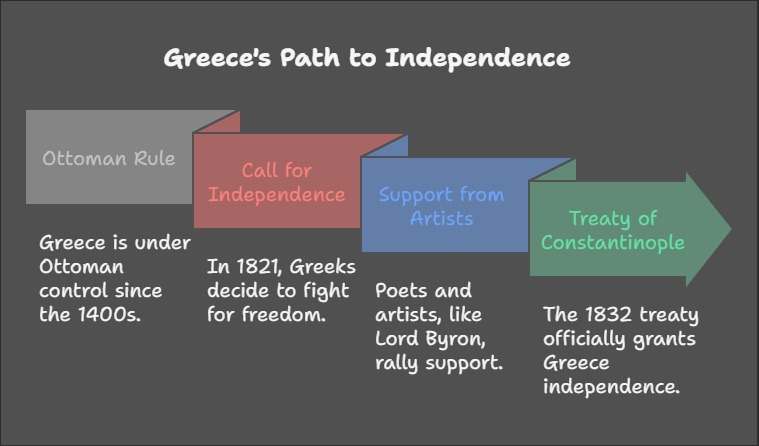
🌍 Revolution Checklist: 1830-1848
| Region | What Happened? | Key Players |
|---|---|---|
| France | Bourbon kings overthrown | Louis Philippe, middle-class rebels |
| Belgium | Broke free from Netherlands | Liberal-nationalists |
| Greece | Gained independence from Ottomans | Lord Byron, Greek exiles |
Real-Life Connection:
Think of these revolutions as trending hashtags – once one started, others retweeted! 📢
📚 Test Your Knowledge!
MCQs (Pick the Right Answer): The Rise of Nationalism in Europe
- What triggered revolutions across Europe after 1830?
a) A viral dance challenge
b) France’s July Revolution
c) A potato shortage 🥔
Answer: b) France’s July Revolution. - Why did West Europeans support Greece?
a) They loved Greek salads
b) They admired ancient Greek culture
c) They wanted Ottoman recipes
Answer: b) Admired ancient Greek culture.
Assertion & Reason:
- Assertion: Lord Byron’s role in Greece was symbolic.
Reason: He died fighting for Greek independence.
a) Both true, and reason explains assertion.
b) Both false.
Answer: a) Both true.
Short Questions:
- Name one country inspired by France’s 1830 revolution.
Answer: Belgium. - What treaty recognized Greek independence?
Answer: Treaty of Constantinople (1832).
🌟 Food for Thought!
If your school fought for independence like Greece, what symbol would you use on your flag? A book? A sports trophy?
🎨 Sneak Peek: The Romantic Imagination & National Feeling
What if I told you that poems, art, and folk dances secretly fueled nationalism? Next, we’ll see how painters, writers, and musicians turned culture into a weapon for freedom.
Teaser Question:
Can a poem or a song unite a divided nation? (Hint: Think of Vande Mataram or Tagore’s Ekla Chalo Re!)
🧩 Why Does This Matter?
The Rise of Nationalism in Europe wasn’t just about wars and treaties. It was about people – students, artists, and dreamers – daring to imagine a better world. When you stand up for what’s right, you’re part of this legacy!
Next Up: How emotions, art, and folklore built nations – proving that even a simple song can be revolutionary! 🎶✨
🌟 The Romantic Imagination And National Feeling : How Art and Stories Built Nations!
Imagine your grandma telling you folktales about brave heroes from your region. Those stories make you proud of your roots, right? That’s exactly how Romanticism fueled nationalism in Europe!
Key Idea:
Romantic artists and poets said, “Forget cold logic! Let’s celebrate emotions, folklore, and our shared past!” They used art, music, and stories to make people feel connected as a nation.
🎨 Romanticism vs. Enlightenment: A Cultural Clash!
| Enlightenment 🧠 | Romanticism ❤️ |
|---|---|
| Focused on reason and science | Celebrated emotions and intuition |
| Loved logic and facts | Loved myths and folk tales |
| Example: Isaac Newton | Example: Johann Herder |
Fun Fact:
German philosopher Johann Herder believed true German culture lived in the hearts of common people (das Volk). He said folk songs and dances held the “soul of the nation” (Volksgeist)!
📜 Poland’s Secret Weapon: Music and Language!
Poland was erased from the map in 1795, divided between Russia, Prussia, and Austria. But Poles kept their identity alive through:
- Music: Composer Karol Kurpinski turned folk dances like the polonaise into acts of defiance.
- Language: Russian banned Polish in schools, but priests taught it secretly in churches. Many were jailed!
Story Time:
In 1831, Polish rebels fought Russian rule but failed. Afterward, a priest named Father Robak (not his real name!) risked Siberia to preach in Polish. Why? “Language is the heartbeat of our nation!”
Quote to Remember:
“A nation’s culture resides in the hearts of its people.” – Inspired by Herder.
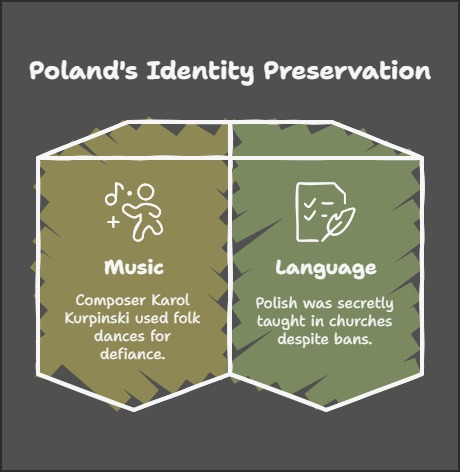
📚 Test Your Knowledge!
MCQs: The Rise of Nationalism in Europe
- What did Romanticism focus on?
a) Science and logic
b) Emotions and folklore
c) Cooking recipes
Answer: b) Emotions and folklore. - Why was Polish language banned in schools?
a) To promote Russian control
b) Poles hated grammar
c) Teachers were on strike
Answer: a) To promote Russian control.
Assertion & Reason:
- Assertion: Herder collected folk songs.
Reason: He believed they carried the nation’s spirit.
a) Both true, and the reason is correct.
b) Both false.
Answer: a)
Short Questions:
- Name one way Poles resisted Russian rule.
Answer: Using Polish in church gatherings. - What is Volksgeist?
Answer: The “spirit of the nation” found in folk culture.
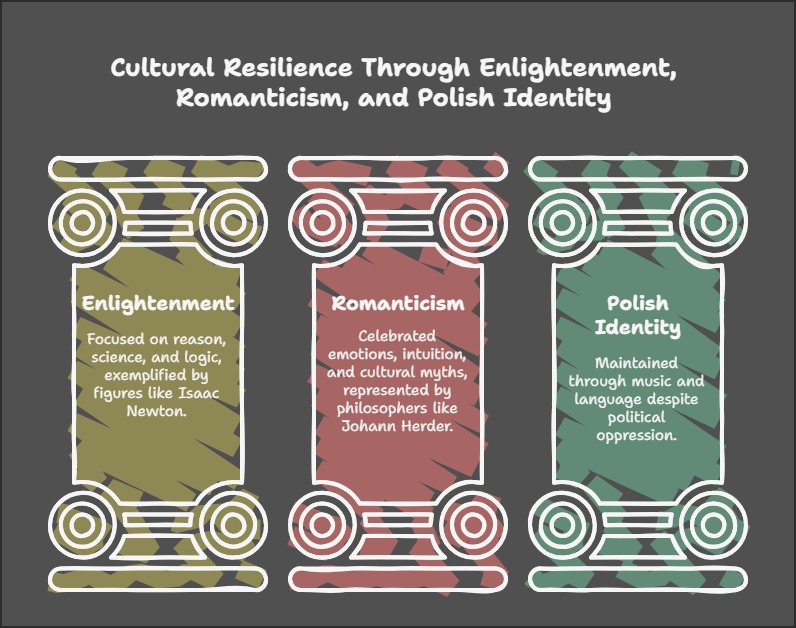
🌟 Food for Thought!
If your state’s traditional dance was banned, how would you keep it alive? Poles used music – what would you do?
🔥 What’s Next? Hunger, Hardship, and Popular Revolt!
Imagine working all day in a factory but still starving. What would you do? Hunger and anger soon mixed with nationalism in Europe, leading to explosive revolts.
Teaser Question:
Can empty stomachs overthrow kings? The 1848 revolutions shouted “Yes!” – but how?
🧩 Why Does This Matter?
The Rise of Nationalism in Europe wasn’t just about battles – it was about pride in who you are. When you sing your state’s folk song or celebrate a festival, you’re keeping your culture alive, just like the Romantics!
Next Up: How bread shortages and worker protests turned into revolutions that reshaped nations! 🍞✊
Hunger, Hardship and Popular Revolt
🌾 Hunger and Hardship: Europe’s Crisis in the 1830s
Picture your city’s population doubling overnight. That’s what happened in 1800s Europe! Jobs vanished, slums grew, and hunger spread. Here’s why:
- Population Boom: More people, fewer jobs. Families moved to cities, living in cramped, dirty homes.
- British Competition: Cheap machine-made clothes from England ruined local weavers. (Imagine Amazon wiping out your local shops!)
- Feudal Burdens: In rural areas, peasants still paid heavy taxes to aristocrats. A bad harvest meant starvation.
Real-Life Connection:
Think of farmers today protesting for fair prices. Back then, weavers and peasants faced similar struggles!
🏙️ City vs. Village: A Tale of Two Crises
| Urban Areas 🌆 | Rural Areas 🌾 |
|---|---|
| Overcrowded slums | Feudal taxes |
| Jobless workers | Starving peasants |
| Cheap British goods flooded markets | Poor harvests = no food |
Story Time: The Silesian Weavers’ Revolt (1845)
In a German village, weavers worked day and night but were paid peanuts. When contractors slashed wages further, the weavers snapped! They marched to their contractor’s mansion, smashed windows, and tore up stored cloth. The army was called – 11 weavers were shot dead.
Quote to Remember:
“The misery of the workers is extreme.” – Journalist Wilhelm Wolff, eyewitness to the revolt.
🔥 1848: The Year Europe Exploded!
By 1848, Europe was a pressure cooker. In Paris:
- Food Shortages: Bread prices soared.
- Unemployment: Factories shut, workshops closed.
- Revolt! Parisians built barricades with furniture, forcing King Louis Philippe to flee.
What Changed?
- A Republic was declared.
- All men over 21 got voting rights (suffrage).
- “Right to Work” became law – government created jobs.
Fun Fact:
1848 is called the “Springtime of Nations” – revolutions bloomed like flowers! 🌸
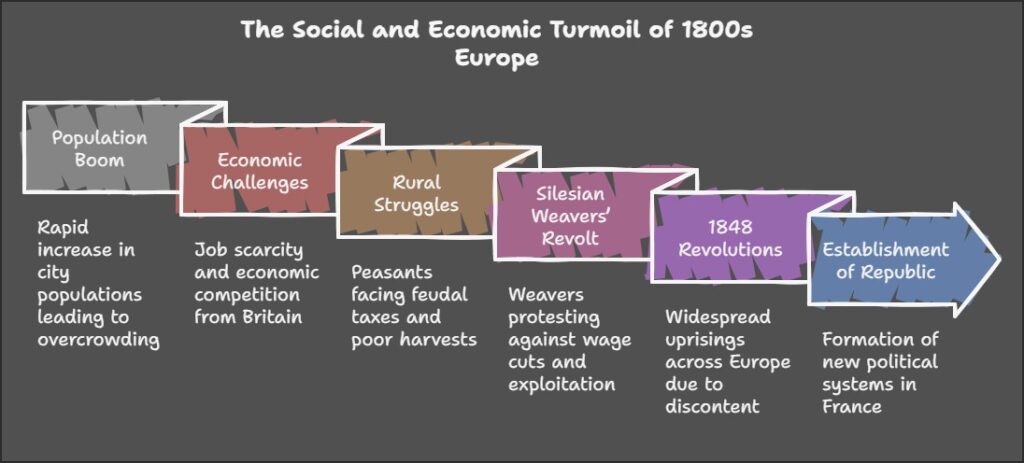
📚 Test Your Knowledge!
MCQs (Choose the Correct Answer): The Rise of Nationalism in Europe
- What triggered the Silesian weavers’ revolt?
a) A new dance trend
b) Drastic wage cuts
c) Too much rain
Answer: b) Drastic wage cuts. - What right did Parisians gain in 1848?
a) Free education
b) Voting for all adult men
c) Free smartphones
Answer: b) Voting for all adult men.
Assertion & Reason:
- Assertion: 1848 saw revolutions across Europe.
Reason: Economic crisis mixed with demands for political rights.
a) Both true, and the reason explains the assertion.
b) Both false.
Answer: a) Both true.
Short Questions:
- Name one problem faced by urban workers in the 1830s.
Answer: Unemployment/competition from British goods. - What happened to the Silesian weavers who protested?
Answer: 11 were shot by the army.
🌟 Food for Thought!
If your family couldn’t afford groceries, would you join a protest? How would you demand change?
🗳️ Coming Next: 1848 – The Revolution of the Liberals!
Imagine students and lawyers leading protests. Liberals saw 1848 as their chance to turn anger into political change. But could they balance workers’ needs with their own dreams of democracy?
Teaser Question:
Can voting rights fix hunger? Liberals said “Yes!” – but workers wondered, “Where’s the bread?” 🍞
🧩 Why Does This Matter?
The Rise of Nationalism in Europe wasn’t just kings and flags. It was hungry families, jobless youth, and brave weavers showing that people power can shake empires! When you fight for fairness today, you’re walking in their footsteps.
Next Up: How liberals tried – and failed? – to turn revolution into a new democratic Europe. 📜⚖️
The Revolution of the Liberals
🌟 1848: When Liberals Took Center Stage!
While workers and peasants fought for bread, educated liberals (lawyers, teachers, businessmen) saw a chance to push for political freedom. Imagine your school’s debate club leading a protest – that’s what happened!
Key Idea:
Liberals wanted:
- Constitutions: Rulebooks to limit kings’ power.
- Press Freedom: Newspapers without censorship.
- National Unity: Merge small states into nations (Germany, Italy).
Fun Fact:
1848 is called the “Springtime of Nations” – but winter came quickly for liberals! ❄️
🏛️ The Frankfurt Parliament: A Dream That Fizzled
In Germany, 831 middle-class men met in Frankfurt’s St. Paul’s Church (May 1848) to draft a constitution. Their plan:
- Unified Germany under a monarch + elected parliament.
- Offer the Crown: To Prussia’s King Friedrich Wilhelm IV.
What Went Wrong?
- The king laughed! “I won’t accept a crown from gutter-snipes!” 👑
- Liberals ignored workers’ demands for better wages, losing public support.
- Soldiers disbanded the parliament. Dream over.
Quote to Remember:
“Authority comes from God, not scribblers.” – King Friedrich Wilhelm IV.
👩💼 Women in 1848: Forgotten Heroes
Women actively joined protests, wrote newspapers, and formed clubs. But in the Frankfurt Parliament:
- No Voting Rights: Only men could elect representatives.
- Silent Observers: Women were allowed only in the gallery, like spectators at a cricket match!
Story Time:
Louise Otto-Peters, a German feminist, wrote: “Women’s work for the nation is invisible, but essential!” Yet, her demands were ignored.
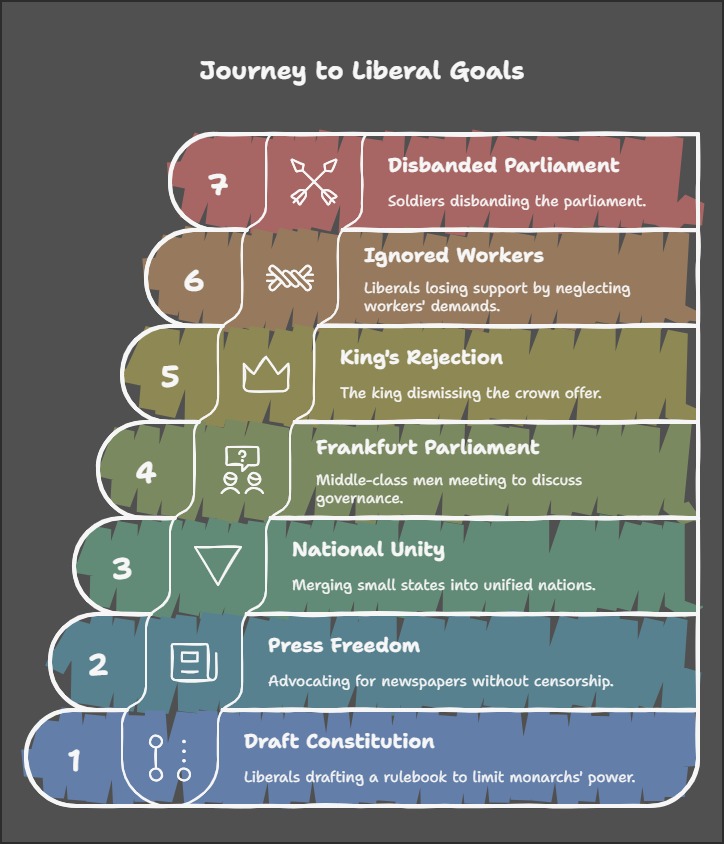
📜 Aftermath: Small Wins, Big Lessons
Though liberals failed in 1848, they scared monarchs into changes:
- Abolition of Serfdom: In Austria and Russia (like India’s end of zamindari).
- Hungarian Autonomy: Habsburgs gave Hungary more self-rule in 1867.
| Liberals’ Demands 📜 | Monarchs’ Concessions 👑 |
|---|---|
| Constitutions | Limited reforms (e.g., ending serfdom) |
| Unified Germany/Italy | Stayed divided for now |
📚 Test Your Knowledge!
MCQs: The Rise of Nationalism in Europe
- Why did the Frankfurt Parliament fail?
a) The king refused the crown
b) Aliens invaded
c) Everyone got bored
Answer: a) The king refused the crown. - What right were women denied in 1848?
a) Education
b) Voting
c) Breathing
Answer: b) Voting.
Assertion & Reason:
- Assertion: The 1848 revolutions scared European monarchs.
Reason: They introduced reforms like abolishing serfdom.
a) Both true, and the reason is correct.
b) Both false.
Answer: a)
Short Questions:
- Name one demand of the 1848 liberals.
Answer: Constitution / National unification. - Who rejected the Frankfurt Parliament’s crown?
Answer: Prussia’s King Friedrich Wilhelm IV.
The Making of Germany and Italy
🌍 From Broken Dreams to New Nations: Germany & Italy!
Imagine trying to solve a 1000-piece puzzle. Liberals in 1848 lost patience, but soon, leaders like Bismarck (Germany) and Garibaldi (Italy) would finish the job!
Teaser:
Can a fiery speech or a daring march turn fragments into nations? Grab your history hats – we’re diving into The Making of Germany and Italy!
🧩 Why Does This Matter?
The Rise of Nationalism in Europe shows that even failed revolutions plant seeds. When you vote in school elections, remember: rights were fought for by dreamers who stumbled before soaring!
Next Up: How “blood and iron” and “red shirts” forged two mighty nations – no magic, just grit! ⚔️
Germany – Can the Army be the Architect of a Nation?
🌟 The Making of Germany: From Fragments to Empire
“Nation-building? Let’s do it with blood and iron!” – Bismarck
After the 1848 liberal revolutions failed, Germany’s unification took a dramatic turn. Forget elected parliaments – this time, Prussia’s army and a tough leader took charge!
⚔️ Otto von Bismarck: The Mastermind
Bismarck, Prussia’s Chief Minister, had a simple plan: unite Germany through war and power, not debates.
His Strategy:
- Three Wars, Seven Years (1864-1871):
- 1864: Defeat Denmark to grab Schleswig-Holstein.
- 1866: Crush Austria to remove rival German states.
- 1870-71: Humiliate France (capturing Alsace-Lorraine).
- Prussian Dominance: Used modernized army, bureaucracy, and alliances with Junkers (Prussian nobles).
Fun Fact:
Bismarck once said, “The great questions of the day will not be settled by speeches… but by blood and iron!” 💥
👑 The Hall of Mirrors Spectacle: Birth of the German Empire
On 18 January 1871, in France’s Palace of Versailles (to rub salt in French wounds!), Prussian King William I was crowned Kaiser (Emperor) of Germany.
Why Versailles?
Symbolic power move! France, defeated in war, had to host Germany’s unification ceremony.
Key Players in the Room:
- Prussian ministers, generals, and German princes.
- Missing: Liberals, workers, and commoners.
📜 Frankfurt Parliament (1848) vs. Bismarck’s Unification (1871)
| Frankfurt Liberals 🕊️ | Bismarck’s Prussia 🦅 |
|---|---|
| Elected parliament | Monarch-led empire |
| Peaceful negotiations | Wars and military force |
| Included middle-class voices | Dominated by Junkers & army |
| Failed due to lack of support | Succeeded through brute strength |
Real-Life Analogy:
Imagine your school’s debate club (Frankfurt) vs. the football team captain (Bismarck) taking over the principal’s office!
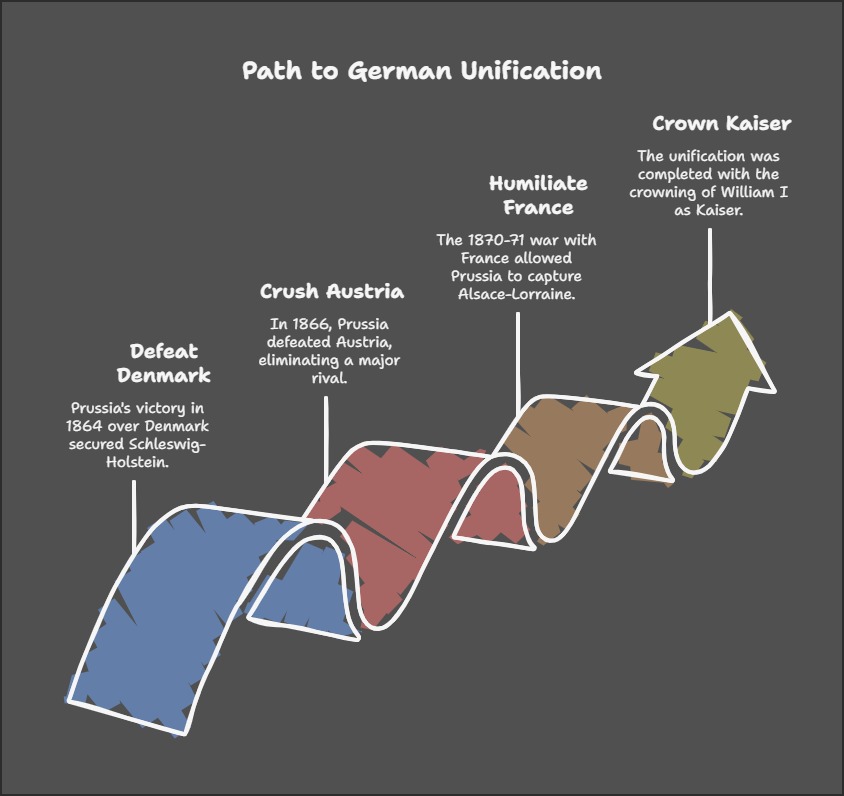
🏛️ Modernizing Germany: Prussia’s Legacy
After unification, Prussia’s systems became Germany’s blueprint:
- Standard currency and banking.
- Unified legal codes.
- Strong central bureaucracy.
But at What Cost?
- Democracy was sidelined.
- Militarism and authoritarianism grew – setting the stage for future conflicts (World Wars).
Quote to Ponder:
“Germany was united not by the people, but by the sword.” – Critics of Bismarck.
📚 Test Your Knowledge!
MCQs: The Rise of Nationalism in Europe
- What was Bismarck’s strategy to unify Germany?
a) Peaceful protests
b) Wars and military force
c) Baking competitions 🎂
Answer: b) Wars and military force. - Where was the German Empire proclaimed?
a) Berlin
b) Palace of Versailles
c) A coffee shop ☕
Answer: b) Palace of Versailles.
Assertion & Reason:
- Assertion: The Frankfurt Parliament failed to unify Germany.
Reason: It relied on democratic debates, not military power.
a) Both true, and the reason explains the assertion.
b) Both false.
Answer: a)
Short Questions:
- Name one war Bismarck fought to unify Germany.
Answer: War with Austria / Denmark / France. - Who were the Junkers?
Answer: Prussian landowners who supported Bismarck.
🧩 What’s Next? Italy’s Dramatic Unification!
Germany used blood and iron – but Italy had romantic heroes, secret societies, and fiery revolutionaries. How did a land of divided kingdoms become one nation?
Teaser Question:
Who wore a red shirt, fought with a sword, and became Italy’s legend? (Hint: His name rhymes with Garibaldi!)
🌍 Why This Matters in The Rise of Nationalism in Europe:
Germany’s story shows how nationalism shifted from people’s dreams to state power and conquest. When unity is forced, not forged by consent, what does it cost? Food for thought as we turn to Italy!
Italy Unified
🌟 Italy’s Unification: From Chaos to Kingdom!
Imagine a puzzle where each piece speaks a different dialect! That’s how Italy looked before unification – divided into 7 states ruled by foreigners. Let’s see how it became one nation!
🗺️ Italy Before Unification: A Divided Land (Early 1800s)
| Region | Ruler |
|---|---|
| North (Lombardy, Venice) | Austrian Habsburgs 🇦🇹 |
| Centre (Rome) | The Pope ⛪ |
| South (Sicily) | Spanish Bourbons 🇪🇸 |
| Sardinia-Piedmont | Italian King Victor Emmanuel II 👑 |
Fun Fact:
The Italian language had regional variations – like how “hello” in Hindi can be “नमस्ते” or “प्रणाम”!
🕵️ Giuseppe Mazzini: The Dreamer Who Lit the Spark
In the 1830s, Mazzini (remember him from earlier?) founded Young Italy, a secret society to create a unified Italian republic. But his revolts failed. Why?
- 1831 & 1848 uprisings crushed by Austria and local kings.
- Lesson Learned: Unification needed an army, not just passion!
Quote to Remember:
“Ideas grow quickly when watered by blood.” – Mazzini
🎩 Cavour: The Smart Strategist
Count Cavour, Sardinia-Piedmont’s Chief Minister, was no idealist. His plan:
- Alliance with France: Tricked Austria into war (1859), won Lombardy.
- Realpolitik: Focused on power, not principles. Spoke French better than Italian!
Real-Life Analogy:
Cavour was like a chess player sacrificing pawns to checkmate Austria! ♟️
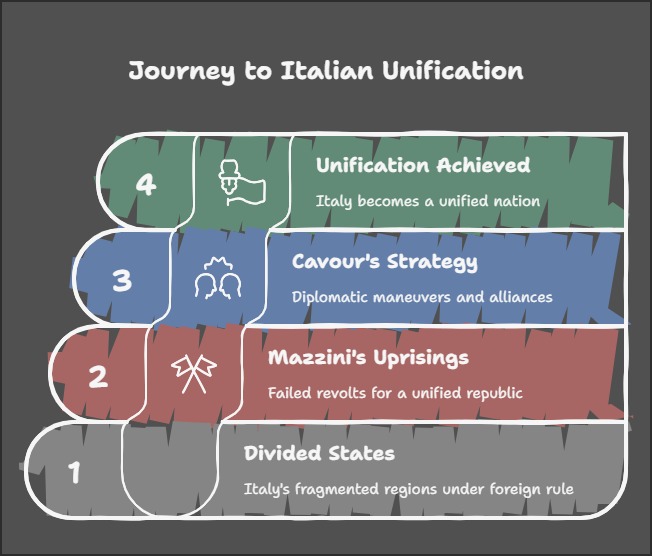
🔴 Garibaldi’s Red Shirts: Heroes of the South!
Giuseppe Garibaldi, a soldier with a flair for drama:
- Led 1,000 volunteers (wearing 👚red shirts) to conquer Sicily and Naples (1860).
- Peasants joined him, thinking “La Talia” was the king’s wife, not their nation! 😂
Why Red Shirts?
They were cheap and visible – like a uniform for a revolution!
👑 1861: Italy Unified… But Not Everyone Celebrated!
Victor Emmanuel II became King of Italy, but:
- South vs. North: Rich industrial north vs. poor agrarian south.
- Illiteracy: Most peasants didn’t understand “Italy” – they just hated foreign rulers!
Irony Alert:
The very people who fought for Italy had no idea what it meant!
📚 Test Your Knowledge!
MCQs (Pick the Correct Answer): The Rise of Nationalism in Europe
- Who led the Red Shirts in southern Italy?
a) Mazzini
b) Garibaldi
c) Cavour
Answer: b) Garibaldi. - Which region was ruled by the Pope?
a) Lombardy
b) Rome
c) Sicily
Answer: b) Rome.
Assertion & Reason:
- Assertion: Cavour allied with France against Austria.
Reason: He wanted to weaken Austria to unify Italy.
a) Both true, and the reason is correct.
b) Both false.
Answer: a)
Short Questions:
- Name one foreign ruler of Italy before unification.
Answer: Austrian Habsburgs / Spanish Bourbons / The Pope. - Why did peasants join Garibaldi?
Answer: To drive out Spanish rulers (not for nationalism).
🌟 Food for Thought!
If you had to spread “Indianness” in a region with 20 languages, how would you do it? (Hint: Think of Italy’s language struggles!)
🏰 Next Up: The Strange Case of Britain!
Italy and Germany fought for unity, but Britain’s nationalism was… weird. How?
Teaser Question:
Can a nation be built without wars or heroes? Britain did it – but was it smooth? 🤔
🧩 Why This Matters in The Rise of Nationalism in Europe:
Italy’s story shows nationalism isn’t just about battles – it’s also myths, mistakes, and misunderstandings. When you sing the national anthem, remember: unity is a journey, not a destination!
🌟 The Strange Case of Britain: A Nation Built by Dominance, Not Revolution
Unlike Germany or Italy, Britain’s unification wasn’t about heroic revolts – it was a slow, top-down process of cultural and political domination. Let’s unravel this “strange” story!
🏴 From Ethnic Identities to “Britishness”
Before the 1700s, people in the British Isles identified as English, Welsh, Scottish, or Irish – not “British.” England’s growing wealth and power (thanks to colonies, trade, and a strong navy) let it dominate its neighbors.
Key Events:
- 1688 Glorious Revolution: Parliament took power from the monarchy, centralizing English control.
- 1707 Act of Union: Merged England and Scotland into the United Kingdom of Great Britain, but English MPs dominated Parliament.
Fun Fact:
Scotland’s Gaelic language and traditional dress (like kilts!) were banned to erase cultural identity. Many Highlanders were forcibly displaced – a dark chapter called the Highland Clearances.
🍀 Ireland’s Tragic Subjugation
Ireland, deeply divided between Catholics (majority) and Protestants (minority), faced brutal oppression:
- Protestant Ascendancy: England backed Protestants to control Catholic-majority Ireland.
- 1798 Uprising: Wolfe Tone’s revolt failed; Ireland was forcibly merged into the UK in 1801.
- Cultural Erasure: Irish culture and language were suppressed, replaced by English norms.
Quote to Remember:
“The Irish were treated not as citizens, but as colonial subjects.” – Historian’s view on British rule.
Forging a “British” Identity: Symbols Over Substance
To unify the UK, England promoted:
- Union Jack Flag: Combined English, Scottish, and Irish crosses.
- National Anthem: God Save the King/Queen (English in origin).
- English Language: Replaced Gaelic, Welsh, and Irish in official use.
Irony Alert:
The “British nation” was less about shared identity and more about English dominance masking itself as unity.
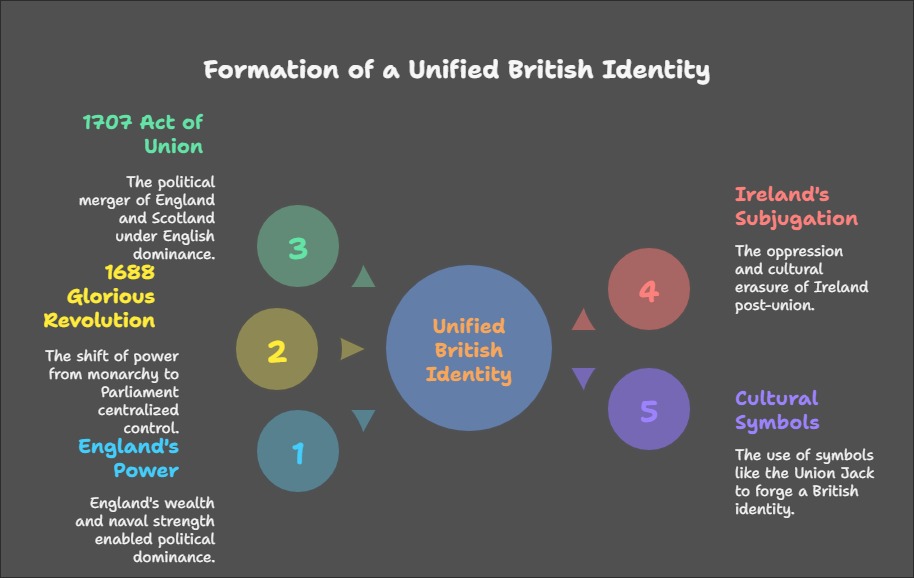
📜 Contrast with Europe: A Different Nationalism
| Germany/Italy | Britain |
|---|---|
| Unified through wars/revolts | Unified through political deals and suppression |
| Celebrated local cultures | Crushed regional identities |
| Led by popular movements | Imposed by elites |
Real-Life Analogy:
Imagine a school where the principal forces all clubs to merge into one, banning their unique traditions. That’s Britain’s unification!
📚 Test Your Knowledge!
MCQs: The Rise of Nationalism in Europe
- What merged England and Scotland in 1707?
a) A royal wedding
b) The Act of Union
c) A football match 🏴⚽
Answer: b) The Act of Union. - Why is Britain’s unification called “strange”?
a) It involved aliens 👽
b) It relied on cultural suppression, not popular revolt
c) It happened overnight
Answer: b) Cultural suppression, not popular revolt.
Assertion & Reason:
- Assertion: The Highland Clearances aimed to erase Scottish culture.
Reason: England sought to impose a uniform British identity.
a) Both true, and the reason explains the assertion.
b) Both false.
Answer: a)
Short Questions:
- Name one symbol promoted to create British identity.
Answer: Union Jack / National anthem / English language. - What happened after Wolfe Tone’s 1798 revolt?
Answer: Ireland was forcibly merged into the UK in 1801.
🌍 Next Up: Visualising the Nation – Art & Symbols!
How do flags, statues, and paintings turn abstract ideas into national pride? Let’s explore how artists literally painted nationalism into existence!
Teaser Question:
Can a painting of a woman with a torch unite a country? (Hint: Think of Marianne in France!)
🧩 Why This Matters in The Rise of Nationalism in Europe:
Britain’s story reminds us that nationalism isn’t always liberating – it can also erase cultures under the guise of unity. When we celebrate national symbols today, whose stories are we forgetting?
🌟 Visualising the Nation: How Art Gave Faces to Countries!
Imagine if your school had a mascot that represented every student’s spirit. That’s how artists in the 1800s created female allegories to symbolise nations! Let’s explore how abstract ideas like “freedom” or “unity” got a human face.
🎨 Nations as Women: Why Female Allegories?
Artists struggled to draw something as big as a nation. So, they personified countries as women! These figures weren’t real people but embodied national values:
- Liberty, Justice, Republic: Common themes from the French Revolution.
- Symbolic Objects: Red caps (freedom), scales (justice), flags (unity).
Fun Fact:
Using women symbolized nurturing and purity, but real women were often excluded from political rights!
🇫🇷 Marianne: France’s Revolutionary Icon
Marianne, the French allegory, was inspired by Liberty and the Republic. She wore:
- A red Phrygian cap (worn by freed slaves in ancient Rome).
- The tricolour flag.
- A cockade (revolutionary badge).
Where Did You See Her?
- Coins, stamps, and statues in town squares!
- Meant to remind people: “We’re all one nation!”
Germania: Germany’s Warrior Muse
For Germany, Germania became the national symbol. Her traits:
- Crown of oak leaves (German oak = heroism).
- Sword and shield (readiness to defend the nation).
- Black-red-gold flag (liberal hopes from Sorrieu’s painting!).
| Marianne (France) 🗽 | Germania (Germany) 🛡️ |
|---|---|
| Red cap, tricolour | Oak crown, sword |
| Symbolised liberty & revolution | Symbolised strength & unity |
| Used on coins/stamps | Featured in political posters |
Quote to Ponder:
“A nation’s symbols are mirrors of its soul.” – Inspired by Romantic thinkers.
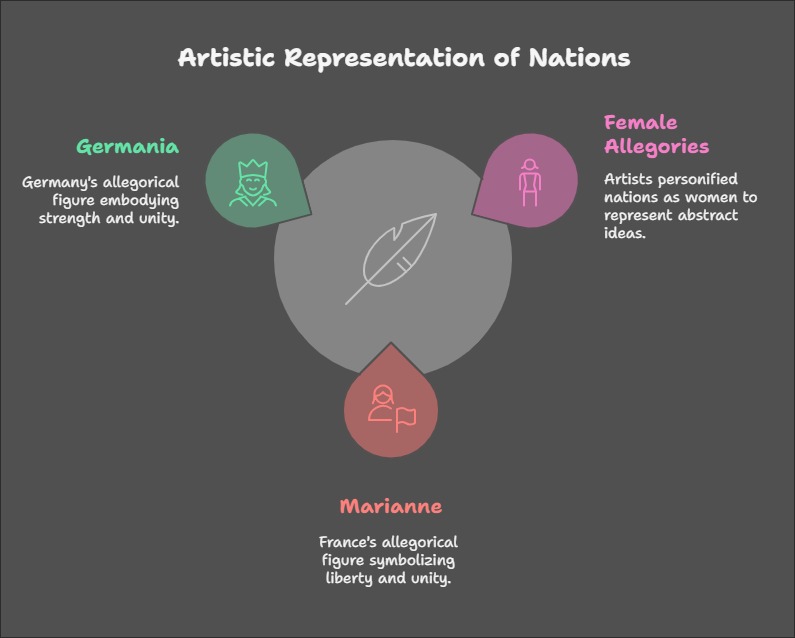
📚 Test Your Knowledge!
MCQs (Choose the Correct Answer):
- What did Marianne’s red cap symbolise?
a) Fashion
b) Freedom
c) Cooking skills
Answer: b) Freedom. - Why was Germania shown with an oak crown?
a) Oak trees represent German heroism
b) She loved gardening
c) It was trendy
Answer: a) Oak trees represent heroism.
Assertion & Reason:
- Assertion: Female allegories excluded real women from power.
Reason: They symbolised ideals but didn’t grant women rights.
a) Both true, and the reason explains the assertion.
b) Both false.
Answer: a) Both true.
Short Questions:
- Name two symbols associated with Marianne.
Answer: Red cap, tricolour flag. - What did Germania’s sword represent?
Answer: Readiness to defend the nation.
🌟 Food for Thought!
If your country had a mascot, what symbols would it hold? A book? A tool? A sport?
🌍 From Unity to Domination: Nationalism’s Dark Side
Artists used symbols to unite people, but what happens when national pride turns into a desire to control others? Nationalism and Imperialism explores how love for one’s nation sometimes led to conquering foreign lands.
Teaser Question:
Can loving your country too much make you harm others? The Age of Empires holds the answer…
Next Up: How the pride in national symbols morphed into empires ruling distant lands – a story of power, greed, and resistance. 🌐⚔️
🧩 Why Does This Matter?
The Rise of Nationalism in Europe shows how art and culture shape identity. But symbols can be double-edged – uniting some, excluding others. When you salute your flag, remember: nationalism’s story is complex!
🌍 Nationalism and Imperialism: From Unity to Conflict
Imagine your school project group turning into rivals fighting over who gets credit – that’s how nationalism in Europe spiraled into imperialism and war! Let’s break down this crucial shift.
🕰️ The Dark Turn of Nationalism
By the late 1800s, nationalism lost its idealistic vibe and became aggressive:
- From Unity to Conflict: Nationalist groups grew intolerant, ready to fight over territory.
- Tool for Empires: Big powers like Britain and Germany manipulated nationalist movements to expand their own empires.
Fun Fact:
Nationalism’s slogan changed from “We the people!” to “Our nation first – at any cost!”
💣 The Balkans: Europe’s Powder Keg
The Balkans (modern-day countries like Serbia, Greece, Croatia) became a hotspot because:
- Ethnic Diversity: Slavs, Greeks, Albanians, and others lived under the weakening Ottoman Empire.
- Rising Independence Movements: Inspired by romantic nationalism, Balkan states revolted against Ottoman rule.
- Territorial Greed: Newly independent Balkan nations fought each other for land.
| Country | Claim to Independence |
|---|---|
| Serbia | “We were medieval rulers here!” |
| Greece | “We’re the heirs of ancient Athens!” |
| Bulgaria | “We deserve land for our ethnic majority!” |
Real-Life Analogy:
Think of siblings fighting over a pizza – each insisting they deserve the biggest slice!

🕵️ Imperial Manipulations: Europe’s Game of Thrones
Major powers saw the Balkans as a chessboard:
- Russia: Supported Slavs to gain access to the Mediterranean.
- Austria-Hungary: Feared Slavic rebellions in its own empire.
- Germany & Britain: Wanted to block rivals’ influence.
Quote to Remember:
“The Balkans produce more history than they can consume.” – Winston Churchill
💥 From Balkan Wars to World War I
The rivalry exploded in 1914:
- Assassination of Archduke Franz Ferdinand (Austria’s heir) by a Serbian nationalist lit the fuse.
- Alliance System: Countries dragged into war due to treaties (e.g., Germany backing Austria, Russia backing Serbia).
Did You Know?
World War I was nicknamed “The War to End All Wars” – but it only sowed seeds for WWII.
🌟 Nationalism’s Double Role: Oppressor and Liberator
While Europe descended into chaos, colonized nations (Asia, Africa) used nationalism to fight back:
- Anti-Imperial Movements: Leaders like Gandhi (India) and Sun Yat-sen (China) blended local culture with nationalist ideas.
- Unique Identities: Unlike Europe, these movements united people against foreign rule, not other ethnic groups.
Example:
India’s “Unity in Diversity” vs. Europe’s “My nation first!”
📚 Test Your Knowledge!
MCQs: The Rise of Nationalism in Europe
- Why were the Balkans called Europe’s “powder keg”?
a) They produced gunpowder
b) Ethnic tensions made war likely
c) It was a mining region
Answer: b) Ethnic tensions made war likely. - What triggered World War I?
a) A food shortage
b) Assassination of Franz Ferdinand
c) A soccer match
Answer: b) Assassination of Franz Ferdinand.
Assertion & Reason:
- Assertion: European powers exploited Balkan nationalism.
Reason: They wanted to expand their own empires.
a) Both true, and the reason explains the assertion.
b) Both false.
Answer: a)
Short Questions:
- Name two European powers involved in Balkan rivalry.
Answer: Russia, Austria-Hungary, Germany, Britain. - How did colonized nations use nationalism differently?
Answer: To unite against imperial rulers, not fight neighbors.
🌍 Food for Thought!
If your class had to resolve a conflict without violence, what would you do? The Balkans needed this lesson in 1914!
🔍 Why This Matters Today
Nationalism’s Legacy: It can unite or divide – the choice depends on how we wield it. From the Balkans to India, history teaches us: Pride in identity shouldn’t mean erasing others’!
Next Time: Reflect on how art and culture continue to shape national identities in our globalized world! 🎨🌐
📜 Recap Table: Nationalism Then vs. Now
| 19th-Century Europe 🌍 | Colonized Nations 🌏 |
|---|---|
| Led to wars and imperialism | Fought for freedom |
| Divided ethnic groups | United diverse cultures |
| Symbolized by allegories like Germania | Symbolized by leaders like Gandhi |
Final Note: Nationalism isn’t good or bad – it’s a tool. Use it wisely!
Conclusion:
“The Rise of Nationalism in Europe” – Why This Chapter Isn’t Just History, But a Mirror to Our World 🌍
What if the passion of revolutionaries, the cunning of leaders like Bismarck, and the silent resistance of suppressed cultures hold the key to understanding today’s headlines? Nationalism didn’t just reshape Europe—it redefined how we see identity, power, and freedom forever.
📜 In a Nutshell:
From the hopeful sparks of 1848 to the explosive Balkan tensions that ignited World War I, nationalism was a double-edged sword. It united millions under flags like Germany and Italy but also sowed seeds of division, imperialism, and conflict.
Artists painted nations as heroic women (Marianne, Germania), while leaders like Mazzini and Garibaldi became legends. Yet, beneath the glory lay struggles—peasants fighting for bread, women denied votes, and cultures erased in the name of “unity.”
💡 Why Should You Care?
- Exam Edge: This chapter isn’t just dates—it’s cause-effect chains (French Revolution → Napoleonic Code → German unification) that CBSE loves such things in framing questions. Crack it with tables, stories, and quizzes tailored for your syllabus.
- Life Lesson: Nationalism’s journey—from liberation to destruction—teaches us: Pride in identity can uplift or divide. The choice is ours.
🚀 For the Curious Minds:
- Ever wondered why India’s “Unity in Diversity” feels like a miracle? Europe’s struggles with fragmented identities hold clues.
- How is today’s globalism vs. nationalism debate echoing 19th-century Europe?
🔥 A Call to Action for Every Student:
If you skipped straight here, ask yourself: *Can you afford to miss a story where:
- A failed artist’s dream (Sorrieu) predicted Europe’s map?
- Bismarck’s “blood and iron” tactics outshine Game of Thrones plots?
- A red-shirted hero (Garibaldi) united Italy while peasants thought “La Talia” was his wife?
“The Rise of Nationalism in Europe” isn’t a dusty chapter—it’s a blueprint for understanding modern geopolitics, unity movements, and cultural pride. Master it not just for exams, but to decode the world you live in.
📖 Ready to Turn History into Your Superpower? Go back, dive into the full guide, and discover how liberals, conservatives, and rebels wrote a saga that still shapes nations. Your Good marks —and your perspective on today’s world—will thank you! 🌟
🌟FAQs for “The Rise of Nationalism in Europe” 🌟
1. What is Nationalism?
Nationalism is the ideology that emphasizes loyalty and devotion to a nation, often based on shared culture, language, history, or political goals. In 19th-century Europe, it fueled movements for nation-states (like Germany and Italy) and challenged empires (e.g., Ottoman, Habsburg).
2. Write a note on Giuseppe Mazzini.
Giuseppe Mazzini was the “Soul of Italian Unification”, a revolutionary who founded Young Italy (1831) to create a unified Italian republic. His vision inspired liberal-nationalists across Europe, though his uprisings failed. Conservatives like Metternich called him the “most dangerous enemy”.
3. Write a note on Count Camillo de Cavour.
Count Camillo de Cavour, the “Brain of Italian Unification”, was the Prime Minister of Sardinia-Piedmont. Using diplomacy and alliances (e.g., with France), he defeated Austria (1859) and unified Northern Italy. Unlike Mazzini, he favored monarchy over republic.
4. What steps did the French Revolutionaries take to create a sense of collective identity?
- Introduced the tricolour flag and national hymns.
- Abolished feudal dues, standardized weights, and promoted French as the national language.
- Celebrated Liberty, Equality, Fraternity as core ideals.
5. Briefly trace the process of German unification.
- 1864-1871: Prussia’s Otto von Bismarck used “blood and iron” (wars against Denmark, Austria, France).
- 1871: Prussian King William I proclaimed German Emperor at Versailles, uniting 39 states into a nation-state.
6. Why did nationalist tensions emerge in the Balkans?
- Ottoman decline: Weak control over diverse ethnic groups (Slavs, Greeks).
- Romantic nationalism: Claims of historical independence.
- Imperial rivalry: Russia, Austria, and others exploited tensions, leading to WWI.
7. How was the history of nationalism in Britain unlike the rest of Europe?
Britain unified through political dominance, not revolution:
- 1707 Act of Union merged England and Scotland.
- Cultural suppression: Banned Gaelic, crushed Irish revolts.
- No “British nation” until the 18th century.
8. How do I study “The Rise of Nationalism in Europe” for Class 10?
- Focus on timelines: French Revolution → 1848 Revolutions → Unifications.
- Use mind maps: Link key figures (Mazzini, Bismarck) to events.
- Practice maps: Mark the Balkans, German states, and Italian regions.
9. How can Class 10 History Chapter 1 Q&A help score good marks?
- CBSE pattern: Focus on 3-5 markers (e.g., Mazzini’s role, German unification).
- Keyword emphasis: Use terms like liberalism, Zollverein, imperialism.
- Previous papers: Revise questions on symbols (Marianne, Germania).
10. What’s the difference between liberalism and nationalism?
- Liberalism: Focused on individual rights, constitutions, and free markets (e.g., middle-class demands in 1848).
- Nationalism: Aimed at political unity based on shared identity (e.g., German/Italian unification).
Key Themes to Remember
- Core Concepts: Nation-state, conservatism vs. liberalism.
- Symbols: Marianne (France’s liberty), Germania (German heroism).
- Geopolitical Flashpoints: Balkans, Versailles Treaty, Vienna Congress.
📚 Pro Tip: Use tables to compare unification processes (Germany vs. Italy) and flowcharts for events like the French Revolution’s impact. Ace your exams by connecting dots between romanticism, revolts, and realpolitik! 🚀
You may also like to understand Gender Religion and Caste


